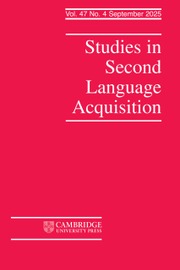No CrossRef data available.
Article contents
HOW DO LEARNERS PERCEIVE INTERACTIONAL FEEDBACK?
Published online by Cambridge University Press: 07 March 2001
Abstract
Theoretical claims about the benefits of conversational interaction have been made by Gass(1997), Long (1996), Pica (1994), and others. The Interaction Hypothesis suggests thatnegotiated interaction can facilitate SLA and that one reason for this could be that, duringinteraction, learners may receive feedback on their utterances. An interesting issue, which haschallenged interactional research, concerns how learners perceive feedback and whether theirperceptions affect their subsequent L2 development. The present research addresses the first ofthese issues–learners' perceptions about interactional feedback. The study,involving 10 learners of English as a second language and 7 learners of Italian as a foreignlanguage, explores learners' perceptions about feedback provided to them throughtask-based dyadic interaction. Learners received feedback focused on a range ofmorphosyntactic, lexical, and phonological forms. After completing the tasks, learners watchedvideotapes of their previous interactions and were asked to introspect about their thoughts at thetime the original interactions were in progress. The results showed that learners were relativelyaccurate in their perceptions about lexical, semantic, and phonological feedback. However,morphosyntactic feedback was generally not perceived as such. Furthermore, the nature as wellas the content of the feedback may have affected learners' perceptions.
Information
- Type
- Research Article
- Information
- Copyright
- 2000 Cambridge University Press
- 812
- Cited by

